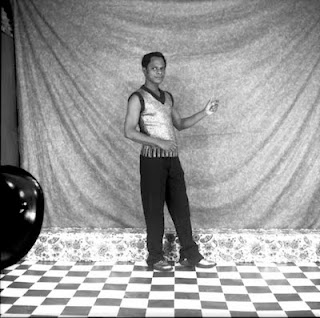Via 123rf.com
I am in the midst of slapping together my general thoughts on the state of the vintage clothing, as seen through the eyes of an overdressed, bi-cultural West African in late 2011 London; as such, the article is guaranteed to be impractical to all that are interested in quality guides, reputable dealers and low grade polyester
Fortunately for everyone else, there are enterprises such as Devoted 2 Vintage that care for the practical side of informed decisions. As such, when I received an e-mail this morning offering '5 Tips to Identify Real Vintage,' I saw no reason not to disseminate it in the column. It concerns women's vintage entirely, which is perfect for my purposes - my eventual article will have a decidedly XY slant:
5 Top Tips to Identifying Vintage Clothing
Have you ever bought a "vintage" dress or shirt only to find out later that it is actually a modern reproduction? Well you are not alone, we see modern clothing everywhere you go purporting to be vintage either because the seller doesn't have the experience or are simply trying to cash.
We would like to share some of our experience with 5 Top Tips to help you avoid making this mistake and maybe find that hidden vintage gem. There are always exceptions but by following these simple checks you should be able to avoid many mistakes.Indicator 1 - Look at the Zip!Does the dress have a metal or vinyl zip? Vinyl zips were not widely used on dresses until mid-late 1960's so the presence of a metal zip could indicate a pre-1970's dress. The location of the zip is also a key indicator. Also the location of the zip is important. Up to the 1950s the zips were often placed at the side of the dress, moving to the back during the 1950s and 1960s.
Indicator 2 - Look at the labels.There are three types of labels to look for; the makers label, the size label and care label. There is an excellent vintage label resource on the Vintage Fashion Guild web page were you can look up most important vintage labels. If you can't find your label here look at the other labels. Before the 1960's the size labels typically indicated the hip size in inches, after this sizes such as 12, 14 etc. were more commonly used. These standard sizes have change over the years so a 14 in the 1960s is equivalent to a 1970's size 12 and modern size 10 so check the bust measurement. Care labels are also a good indicator; they were only introduced in the mid 1960's and only became widely used in the 1970s. The Pure New Wool symbol was only introduced in the 1970s. The absence of any labels would normally indicate that the dress was home made and very common before the 1970's
Indicator 3 - Look at the Garment Construction.Vintage dresses are more likely to be hand made with details like hook and eye fasteners and poppers to secure the garments. Also, internal bra straps were common in the 1950s. Underskirts were common in the 1950's; look for net and muslin underskirts, often with metal hoops sewn in the hem to give the skirts more volume.
Indicator 4 - Feel The fabric.This is a skill that will be developed by handing vintage clothes. Modern mass produced fabrics are rarely the same quality as vintage fabrics. So it is worth spending time in a reputable vintage shop feeling the fabrics, when you then compare this with a modern dress the differences are apparent. The type of fabric used is also a good way of dating dresses. Rayon and taffeta were widely used in the 1950's and in the 1960's polyester; nylon and Crimpolene were commonly used. Lycra was only introduced in the 1980's.
Indicator 5 - Look at the Style of the Dress.This alone is not an accurate indicator because there are many vintage styles have been reproduced over the years. The 1940's shoulder pads were widely used but were also popular in the 1980's. The two most popular styles in the 1950's were the shirtwaist dress, with buttons to the front, a nipped in waist and full pleated skirt and the wiggle dress with lovely fitted hourglass shape. The 1960's saw the introduction of the classic mini skirt and simple shift dress. The maxi dress became more popular in the late 1960's and into the 1970's. The more flamboyant 1970s demanded more fitted styles with plunging necklines and angel sleeves.
Using all these key indicators should lead you through the minefield of buying vintage and help to prevent you from making mistakes. As your collection grows so will your experience and confidence but as long as you buy items that you love then even the mistakes don't matter too much.






























